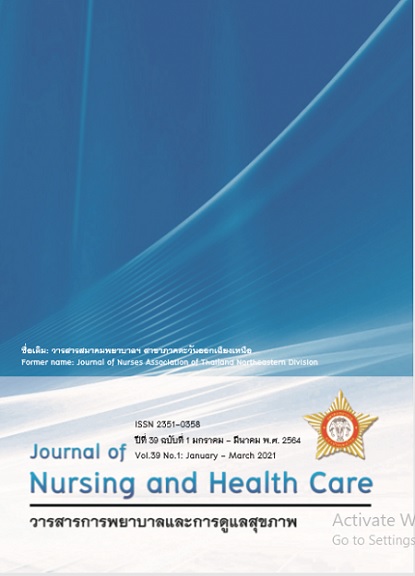The ปัจจัยที่สัมพันธ์กับภาวะถอนพิษสุราในผู้ป่วยที่ดื่มสุราแบบเสี่ยง หอผู้ป่วยรวมเมตตา แผนกออร์โธปิดิกส์ โรงพยาบาลอุดรธานี
คำสำคัญ:
คำสำคัญ ภาวะถอนพิษสุรา ผู้ดื่มสุราแบบเสี่ยง ปัจจัยสัมพันธ์ แผนกออร์โธปิดิกส์บทคัดย่อ
การวิจัยนี้เป็นการวิจัยเชิงพรรณนาแบบย้อนหลังและไปข้างหน้า (Retro- Prospective research) มีวัตถุประสงค์เพื่อศึกษา (1) การเกิดภาวะถอนพิษสุราและ (2) ปัจจัยสัมพันธ์กับการเกิดภาวะถอนพิษสุราของผู้ป่วยที่ดื่มสุราแบบเสี่ยงและเข้ารับการรักษาในหอผู้ป่วยรวมเมตตา โรงพยาบาลอุดรธานี กลุ่มตัวอย่าง คือผู้ป่วยที่มีพฤติกรรมการดื่มสุราแบบเสี่ยงที่เข้ารับการรักษาในหอผู้ป่วยระหว่างปี พ.ศ. 2557-2561 จำนวน 160 คน ได้รับการสุ่มตัวอย่างอย่างง่าย เก็บข้อมูล 2 ส่วนคือ 1) เก็บข้อมูลย้อนหลังจากแฟ้มประวัติ และ 2) เก็บข้อมูลไปข้างหน้าจากผู้ป่วยที่เข้ารับการรักษาในระหว่างเดือนตุลาคม พ.ศ.2561-สิงหาคม 2562 เครื่องมือที่ใช้ในการวิจัยคือ 1) แบบคัดกรองพฤติกรรมการดื่มสุราแบบเสี่ยง (AUDIT) 2) แบบประเมินอาการขาดสุรา (CIWA-Ar) และ 3) แบบบันทึกประวัติและผลตรวจร่างกายผู้ป่วยที่มีความเสี่ยงภาวะถอนพิษสุราที่ตรวจสอบความตรงเชิงเนื้อหา(CVI) เท่ากับ 1 วิเคราะห์ข้อมูลได้แก่ ร้อยละ การแจกแจงความถี่ สถิติฟิชเชอร์ไคว์สแควร์ สัมประสิทธิ์สหสัมพันธ์เพียร์สันและการวิเคราะห์ถดถอย Logistic regression analysis
ผลการศึกษา พบว่า กลุ่มตัวอย่างมีพฤติกรรมการดื่มสุราแบบเสี่ยงสูง 24 คน (ร้อยละ 15) พฤติกรรมการดื่มแบบเสี่ยงต่ำ 136 คน(ร้อยละ 85) กลุ่มตัวอย่างเกิดภาวะถอนพิษสุรา 53 คน (ร้อยละ 33.12) ไม่เกิดภาวะถอนพิษสุรา 107 คน (ร้อยละ 66.88) ปัจจัยที่สัมพันธ์กับการเกิดภาวะถอนพิษสุรา ได้แก่ (1) ระดับความเสี่ยงของพฤติกรรมการดื่มสุรา (Adj.OR=32.5,95% CI=5.88 -139.37,p=.000) (2)ความถี่ในการดื่ม (Adj.OR =43.03,95%CI=4.64-98.63,p=.001) (3) การใช้สารเสพติดร่วม (Adj.OR =5.66,95%CI=1.09-29.29,p=.039) (4)เคยมีภาวะชักมาก่อน (Adj.OR =6.19,95%CI=1.71-22.37,p=.005) (5)เคยมีอาการถอนพิษสุรามาก่อน (Adj.OR =9.15,95%CI=1.99-42.14,p=.004) (6) อายุ (Adj.OR =2.95,95%CI=1.07-8.15,p =.037) (7)ภาวะสมดุลของ Electrolyte (Adj.OR =2.78,95%CI=1.16-6.33,p=.021) (8)ค่า LFT (Adj.OR =3.18,95%CI=1.32-7.69 p=.01) และ(9)ค่าความดันโลหิตซีสโตลิคแรกรับ (Adj.OR =3.99,95%CI=1.85-8.92,p=.002) โดยมีปัจจัยที่มีความสัมพันธ์ทางบวกกับภาวะถอนพิษสุราในผู้ป่วยที่ดื่มสุราแบบเสี่ยงอย่างมีนัยสำคัญทางสถิติที่ระดับ .05 และปัจจัยที่ไม่มีความสัมพันธ์กับภาวะถอนพิษสุราในผู้ป่วยที่ดื่มสุราแบบเสี่ยง ได้แก่ (1)ปริมาณการดื่มต่อครั้ง (2) ผลเลือดค่า BUN และ ( 3) ชีพจรแรกรับ
สรุป ปัจจัยที่มีความสัมพันธ์กับการเกิดภาวะถอนพิษสุราในผู้ป่วยที่มีพฤติกรรมการดื่มสุราแบบเสี่ยงที่เข้ารับการรักษาในหอผู้ป่วยรวมเมตตาทั้งหมด จะช่วยให้พยาบาลนำมาวางแผนการพยาบาลในการดูแลเพื่อป้องกันการเกิดหรือลดความรุนแรงจากภาวะถอนพิษสุราได้อย่างมีประสิทธิภาพ
Downloads
เอกสารอ้างอิง
2. Office of The National Economics and Social Development Council. Thailand Healthy lifestyle Strategic plan, B.E. 2011-2020. [database on the Internet].2010.[cite 2020 Jul 3]. Available from: http:// www.moph. go.th/ops/oic /data/ 20110316100703_1_.pdf.
3. Saegow U, Vichitkunakorn P and Assanangkornchai S. Fact and Figures: Alcohol in Thailand. Songkla: National Library of Thailand Cataloging in Publication Data.2016.
4. Kittirattanapaiboon P.(Editor). Guide for the training of caretakers with basic alcohol drinking problems for health personnel. Chiang Mai: System Development Plan. Patterns and methods of integrated treatment for people with alcohol consumption problems.2011.
5. Ballenger, J.C., & Post, R.M. Kindling as a model for alcohol withdrawal syndromes. British Journal of Psychiatry. 1978:133, 1-14.
6. Thanyanuwat, R. Patients Who Suffers from Alcohol Withdrawal and Disoriented. Utaradit Hospital Medical Journal, 2013:28(2).
7. Fangkaew A. and Dangdomyouth P. Predicting Factors of Alcohol Withdrawal in Alcohol Dependence Clients. The Journal of Psychiatric Nursing and Mental Health.2017:31(2):95-108.
8. Paenkaew J. Alcohol Dependence.Journal of Nursing and Education.2016:9(3)10-19.
9. Kumlue, W. case study: Nursing care for Alcohol dependence with depression. Nursing division Suanprung Psychiatric Hospital, Department of Mental Health, Ministry of Public Health; 2008.
10. Lueboonthavatchai, O. Mental health and Psychiatric Nursing. Bangkok: Chula Book Center, 2011.
11. Phaiboonrungroj P.Alcohol Withdrawal : Nurse Role.. Journal of Nursing Division.2015: 42(1) : 153-162.
12. Records of patients admitted in the ward, Ruam Metta 1 and Ruam Metta 2, Udon Thani Hospital 2011-2018.
13. Hawker,R, & Oxford, J. Predicting alcohol withdrawal severity support for the role Expectation and anxiety. Addiction Research .1998:6(3):256-81.
14. Kraemer, K , and other. Impact of age on the severity, course, and Complications of Alcohol withdrawal. Arch Intern Med. 1997:157(19): 2234-41.
15. Saitz,R.Introduction to alcohol withdrawal. Alcohol health Res world.1998: 22(1): 5-12.
16. Paul Haber, Nicholas Lintzeris, Elizabeth Proude and olga Lopatko. Guideline for the Treatment of Alcohol Problem.2009.
17. Monte, R., Rabunal, R., Casariego, E., Bal,M., Pertega, S. Risk factors for deri.2009.
18. Myrick, H. and Anton, R.F. Treatment of Alcohol withdrawal. Alcohol Health Res Services.1998: 52(6): 820-823.
19. Prescrire. Alcohol withdrawal Syndrome: How to Predict, Prevent, diagnose and treat it. Prescrire International.2007: 16(87):24-31.
20. Burupakajornpong, N.,Maneeton, B., Srisurapanont, M.Pattern and Risk Factors of Alcohol withdrawal Delirium. J med Assoc Thai. 2011:94(8):991-996
21. Khantee N. Selective Factors Associated with Alcohol Depression in Patients with Alcohol Dependence. [Master of Nursing Science Thesis]. Mental Health and Psychiatric Nursing, Faculty of Nursing, Bangkok: Chulalongkorn University, 2013.
22. Thondeike, R.M.Corrlational Procedures for reseach. New York:Garder Press.1987.
23. Silpakit P. and Kittirattanapaiboon P. AUDIT Assessment of Alcohol Drinking Problems, Guidelines for Primary Healthcare Facilities (2nd ed). Bangkok: Sunflower Paper. 2009.
24. Thamawong P. and Damrongchai A. The Confidence of Using CIWA-Ar of Nursing Personnel in Suan Prung Hospital, Chiang Mai.Research Report 2011.
25. Woja, M.,Wasilewski D., Zmigrodzka, I. & Grobel. I. Age-related differences in the couse of alcohol withdrawal in hospitalized patients. Alcohol &Alcoholism. 2001:36(6):577-83.
26. Rothman A, Proverbio T, Fernandez E, Proverbio F. Effect of ethanol on the Na(+) and the Na+, K(+)-ATPase activities of basolateral plasma membranes of kidney proximal tubular cells. Biochem Pharmacol 1992;43: 2034-6.
27. Norasing D, SriKosai S, Somboon S,Hongkham K, Wongwan P, and Kamkhan C. Admission Criteria and Nursing Diagnoses for People with Mental Health Problems Caused by Alcohol Use at Suan Prung Psychiatric Hospital. 2013:29(2):1-15
28. Hartsell Z, Drost J, Wilkens JA, Budavari AI. Managing alcohol withdrawal in hospitalized patients.JAAPA 2007; 20(9): 20-25.



